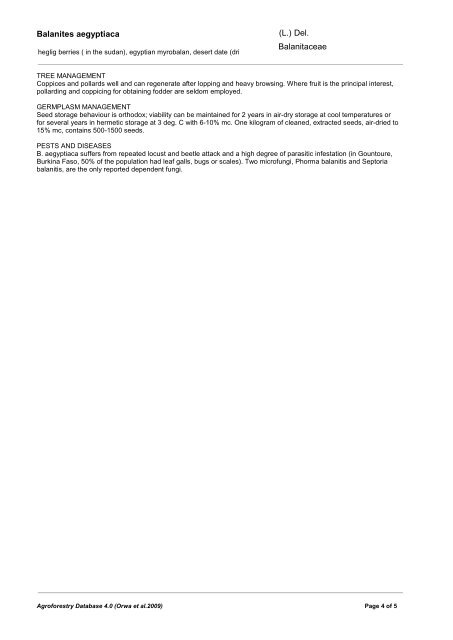Balanites aegyptiaca Balanitaceae - World Agroforestry Centre
Balanites aegyptiaca Balanitaceae - World Agroforestry Centre
Balanites aegyptiaca Balanitaceae - World Agroforestry Centre
Create successful ePaper yourself
Turn your PDF publications into a flip-book with our unique Google optimized e-Paper software.
<strong>Balanites</strong> <strong>aegyptiaca</strong><br />
heglig berries ( in the sudan), egyptian myrobalan, desert date (dried fruit)<br />
(L.) Del.<br />
<strong>Balanitaceae</strong><br />
TREE MANAGEMENT<br />
Coppices and pollards well and can regenerate after lopping and heavy browsing. Where fruit is the principal interest,<br />
pollarding and coppicing for obtaining fodder are seldom employed.<br />
GERMPLASM MANAGEMENT<br />
Seed storage behaviour is orthodox; viability can be maintained for 2 years in air-dry storage at cool temperatures or<br />
for several years in hermetic storage at 3 deg. C with 6-10% mc. One kilogram of cleaned, extracted seeds, air-dried to<br />
15% mc, contains 500-1500 seeds.<br />
PESTS AND DISEASES<br />
B. <strong>aegyptiaca</strong> suffers from repeated locust and beetle attack and a high degree of parasitic infestation (in Gountoure,<br />
Burkina Faso, 50% of the population had leaf galls, bugs or scales). Two microfungi, Phorma balanitis and Septoria<br />
balanitis, are the only reported dependent fungi.<br />
<strong>Agroforestry</strong> Database 4.0 (Orwa et al.2009)<br />
Page 4 of 5

















